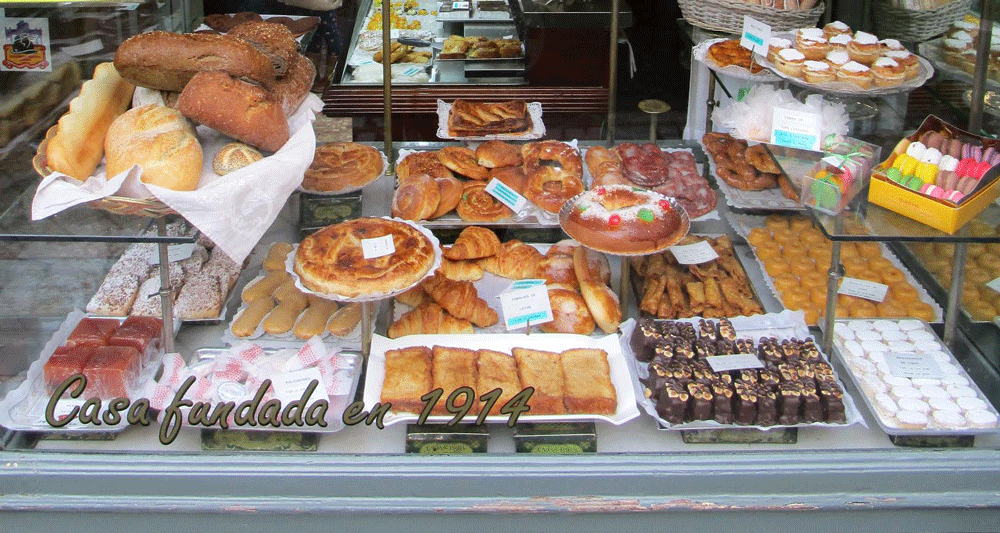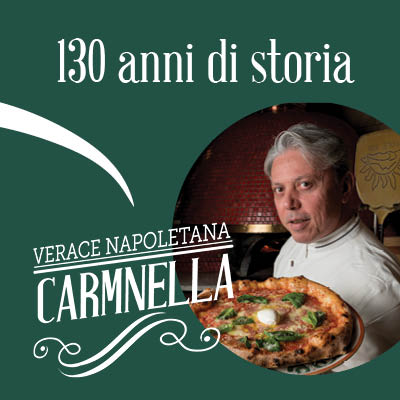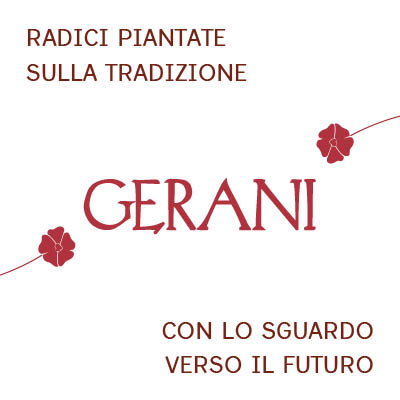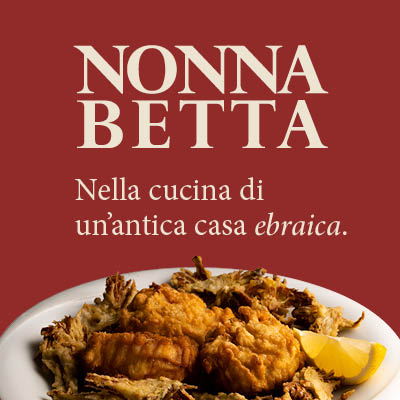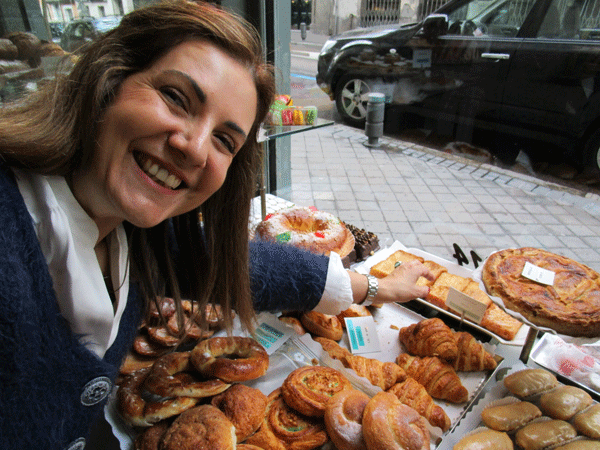A pochi passi dalla Calle Fuencarral, la strada più trendy di Madrid, si trova La Duquesita, un negozio di pasticceria e cioccolato che è circondato da edifici con decorazioni moderniste.
In orario di chiusura, quando le tapparelle sono abbassate, potreste non vedere il negozio. Soltanto il nome elegantemente scritto in oro sul vetro ed i dettagli dorati sulla facciata annunciano la presenza del negozio. Vicino ci sono dei dettagli architettonici più vistosi. In po’ più a ovest c’è il Palazzo Longoria che sembra una torta nunziale con i suoi vortici, le sue ghirlande e i suoi rosoni in stile Art Nouveau. Se sei attento vedi che motivi di animali emergono altrove. Ci sono delle lucertole grigie che strisciano sull’isolato di appartementi all’incrocio. E ci sono dei pinguini su un cornicione basso sull’altro lato della strada di fronte al negozio.
Durante l’orario di apertura, però, la doppia vetrina de La Duquesita compete con tutto quello che la circonda. Ogni mattina il personale del negozio decora le vetrine con più di sei dozzine di tipi di piccola pasticceria, cioccolato, biscotti, tartine, pasta sfoglia, tartufi e marzapane su placche di marmo. Sono tutti già a vista molto deliziosi e la maggior parte è di origine spagnola. Non c’è nemmeno un cupcake.
La Duquesita, fondata 101 anni fa, è rimasta fedele alle antiche ricette come quelle per i dolci fatti a base di mandorle, arance e cioccolato fondente che si preparano in onore dei santi spagnoli.
“Per me non fa senso inventare cose nuove”, dice Luis Santamaria, proprietario, pasticcere e cioccolatiere di 63 anni che gestisce il negozio insieme a sua moglie Teresa. “Ci sono così tanti dolci vecchio stile che non riusciamo a sistemare in vetrina.”
L’interno scuro e fresco del negozio rappresenta un respiro dalla strada luminosa fuori. Qui si può respirare l’odore degli aromi dei dolci, qui si può prendere un caffè e dare un’occhiata alle grandi torte che sono esposte nel bancone frigo rifinito in ottone. Inchiodata su una colonna al centro, sta seduta una duchessa in alabastra che domina la stanza: la duquesita.
La famiglia di Luis ha avuto il negozio in modo inaspettato. Quando il fondatore del negozio, Roque Pérez, un pasticcere e cuoco, morì negli anni 20 del novecento, la sua vedova ha chiesto al nonno di Luis, Romualdo, il quale era arrivato per fare l’apprendista, di continuare l’attività. E così lui continuo con il negozio tenendolo aperto senza pausa anche durante la Guerra Civile Spagnola e durante gli anni di fame che seguirono.
Nel 1936, all’inizio della Guerra, un passante entrò ed attaccò la piccola duchessa, tagliandole la testa. Romualdo la incollò ed continuò ad infornare dolci nonostante sua moglie ed i bambini erano stati evacuati dalla città. Per tre decenni di austerità, mentre spesso gli antichi mobili furono tolti di mezzo per fare spazio alla modernità, Romualdo ed il suo staff lucidarono e spolverarono l’arredamento originale.
Luis ha iniziato a dare una mano in età adolescenziale consegnando a piedi, dopo la scuola, i dolci ai clienti. Più tardi imparò due mestieri, quello del pasticcere e quello del cioccolatiere, lavorando al fianco del nonno e del padre nel laboratorio sotto al negozio. Oggi lui gestisce un team di quattro persone che preparano i dolci e i cioccolatini nel laboratorio sotto al negozio. Quando ha sposato Teresa, andalusa di nascita, nel 1987, lei si è unita allo staff del negozio. E’ lei che sistema i dolci ogni mattina in vetrina.
“Entrando nell’attività da un altro mondo, ho potuto vedere l’arte dietro al mestiere.” dice lei. “Volevo aiutare a Luis a proteggere questo. Non facciamo nessun tipo di marketing, ma spieghiamo sempre ai nostri clienti che cosa c’è in tutti i ns. dolci o cioccolatini. Li spieghiamo esattamente come sono fatti per far capire cosa stiamo facendo.”
Ma La Duquesita è tutto tranne che un patrimonio. Il suo fascino è nel luogo stesso.
E’ invece un’attività di famiglia, una parte della vita quotidiana del quartiere o barrio. Tutti sono trattati allo stesso modo. C’è sempre il tempo per una chiacchierata. Solo gli animali vengono allontanati. I vicini passano per fare una seconda colazione con caffè e dolce. Personaggi famosi che sono in visita al Palazzo Longoria – la sede dell’Associazione degli Artisti Spagnoli – si vedono spesso con dei cartoni di dolci in mano. La loro debolezza per un dolce di La Duquesita va indietro per molto tempo. Negli anni 20 la regina della canzone popolare, Concha Piquer, era cliente del negozio. Oggi il regista Pedro Almodòvar e la scrittrice Almudena Grandes sono clienti abituali. Altri clienti affrontano lunghi viaggi per una guantiera di dolci che non si possono trovare altrove. Il negozio fornisce anche un albergo locale, ma non c’è un franchising.
Luis è un grande artista ma un po’ riluttante. La sua modestia determina lo stile del negozio il quale è basato sul rispetto per le ricette di una volta. Nel negozio si trovano tanti dolci tipici dedicati ai vari santi, ma solo poche creazioni all’avantguardia. I biscotti al burro si preparano per il giorno di S. Antonio a gennaio, quando si fa la benedizione agli animali in chiesa. A giugno in occasione di Sant’Antonio, il santo patrono dei sarti, appaiono nelle vetrine delle seducenti meringhe alle mandorle chiamate suspiros de modistilla (= sospiri delle piccole sarte). A fine autunno, ad Ognissanto, si preparano dei piccoli huesos del santo, le ossa dei santi – piccoli rotoli di marzapane. Sotto Natale, invece, si fa la fila per comprare il torrone duro o morbido e delle anguille di marzapane riccamente ornate.
Luis dice con umiltà che se c’è qualcosa che rende i dolci ed i cioccolatini di La Duquesita speciali, è la materia prima. “L’arrivo del cioccolato concato in Spagna dopo la Guerra è stata la nostra opportunità più grande”. Per lui questo nonché l’arrivo della refrigerazione negli anni sessanta è di importanza fondamentale. Si può assaggiare questa qualità. Quando provi una delle tavolette di cioccolato avvolte in carta come ad esempio la naranjines, quella alle scorze di arancia, noti l’aroma del ricco cioccolato fondente del fornitore francese Valrhona. Le scorze candite della tavoletta naranjines sono un pochino amare e fatte in casa. “A volte i prodotti buoni naturali sono difficili da trovare anche pagandoli qualsiasi prezzo”, dice Luis. “E allora le facciamo in casa.” Ed anche durante la presente crisi economica non si tagliano i costi né si risparmia sul tempo.
Chiaramente ciò comporta sacrifici. Luis e Teresa lavorano 6 giorni la settimana, domeniche incluse. “Ma non si tratta di uno sforzo”, dice Teresa. “E’ normale perché fa parte di ciò che la famiglia tramanda da sempre. Si può anche chiamare il sapere di come fare bene le cose.”
Il papà di Luis ha ricevuto riconoscimenti da vicino e lontano. Lui, invece, ha partecipato e vinto in gare internazionali.
“Ma Luis è più come suo nonno,” dice Teresa. “Suo motto è ‘el premio es el publico todos los dìas’.” Il premio è la gente che viene ogni giorno.
Pasteleria La Duquesita
Calle de Fernando VI, 2,
28004 Madrid, Spagna
Tel. +34 913 08 02 31
http://www.laduquesita.es/
di Vicky Hayward
Dolci nella foto banner.
In senso orario , dal basso a destra . Mantecados Prima fila, soconusas , torrijas , polvorones , membrillo . Seconda linea Lazos , toledanos , empanadas , dolci misti , rosquillas de yema , bayonesa . Carbayones anche indicati , merlitones , palmares ( vetri ) , bartolillo , pestiños , yemas de San Leandro
English Version (Author Vicky Hayward)
A short stroll east from Calle Fuencarral, Madrid’s hippest fashion street, sits La Duquesita, a family-owned cake and chocolate shop surrounded by a cluster of buildings embellished by quirky Moderniste flourishes.
Outside opening hours, when the blinds are closed, you might miss the shop. Only its name, elegantly scripted in gold on glass, and gilded details on the façade, announce its presence. Close by are showier architectural details. A few yards to the west sits the Palacio de Longoria, a wedding-cake of a building swathed with creamy art nouveau swirls, garlands and rosettes. Animal motifs emerge elsewhere if you look carefully. Grey lizards slither up an apartment block at the crossroads. Penguins stand on a low cornice opposite the shop.
But during opening hours La Duquesita’s double window competes well with everything around it. Each morning the shop team lays out over six dozen kinds of small cake, chocolate, biscuit, tartlet, flaky pastry, truffle and marzipan on marble slabs in the window. Delectable to the eye, most are Spanish in origin. There is not a cup cake in sight. Founded 101 years ago, La Duquesita remains true to older recipes, like those for Spanish saints’ days cakes, made with defining flavours like ingredients like almonds, orange and dark bitter chocolate.
“I see no sense in inventing new things,” says Luis Santamaría, patissier and chocolate maker, aged 63, who owns and runs the shop with Teresa, his wife. “There are so many good old-fashioned cakes we cannot fit in the window.”
Dark and cool, the shop’s interior is a respite from the bright street. Here you can breathe in cake-making aromas, enjoy a coffee and gaze at large cakes laid out in brass-trimmed and chiller cabinets. Overlooking it all, on an iron bracket nailed to a central column, sits a small alabaster duchess, la duquesita.
Luis’s family came to own the shop unexpectedly. When Roque Pérez, the pastry-cook who founded it, died in the 1920s, his widow asked Luis’s grandfather, Romualdo, who arrived here as the shop’s apprentice, to take on the business. He kept the shop going, without a pause, right through the Spanish Civil War and years of hunger that followed.
In 1936, at the start of the war, a passer-by entered the shop and attacked the little duchess, knocking off her head. Romualdo stuck it back on and carried on baking though his wife and children were evacuated from the city. For three decades of austerity, when often antique interiors were swept aside for modernity, he and his team immaculately polished and dusted the original furnishings.
Luis began to help out as a teenager, delivering cakes on foot to local clients after school hours. Later he learned two crafts, those of pâtissier and chocolate maker, working alongside his grandfather and father in the shop’s basement. Today he leads a team of four who make the cakes and chocolates in the underground workshop. When he married Teresa, Andalusian born, in 1987 she joined the shop team.
It is Teresa who lays out the cakes in the window every morning.
“Coming to the business from another world I could see the art behind the craft.” she says. “I wanted to help Luis protect that. We don’t do any marketing, but we always explain to customers what goes into each cake or chocolate, exactly how each of them is made, so they can understand what we do.”
But La Duquesita is anything except a heritage spot. That is one of its charms.
Instead it’s a family business, part of everyday life in the barrio or quarter. Everyone is treated the same way. There is always time for a chat. Only pets are turned away.
Neighbours drop by for a late breakfast cake and coffee. Well known figures on a working visit to the Palacio de Longoria, home to the copyright association of Spanish artists, may often be seen emerging cake-box in hand. Their weakness for La Duquesta’s cakes goes back a long way. In the 1920s Concha Piquer, queen of popular song, was a client. Today film-maker Pedro Almodóvar and writer Almudena Grandes are regular visitors. Other clients may make a long journey here for a trayful of cakes, things they can no longer find elsewhere. They also supply a local boutique hotel, but there is no franchising.
Luis is a virtuoso, but a reluctant one. His modesty shapes the house style, which is based on respect for time-honoured formulas. The shop displays plenty of old-fashioned saint’s days cakes, but few avant-garde creations. Butter biscuits are baked for San Anton’s day in January when animals are blessed at the local church. Luscious almond meringues called suspiros de modistilla, little dressmaker’s sighs, appear in the window in June in time for San Antonio, the feastday of the dressmakers’ patron saint. As autumn turns to winter little huesos del santo, or saints’ bones, marzipan rolls, are made for All Saints’ Day. Come Christmas and queues stretch down the pavement for the shop’s turrones, or soft and hard nougats, and ornate marzipan eels.
Luis says, again modestly, that if anything makes La Duquesita’s cakes and chocolates special it’s their raw materials. “The arrival of quality conched chocolate in Spain after the war was our greatest new opportunity,” he says. He lays as much importance on that as the arrival of refrigeration in the 1960s. You can taste this quality. If you are given a paper-wrapped packet of the shop’s chocolates, like its orange-zest naranjines, you notice the dark rich chocolate from supreme French supplier Valrhona. The orange zest in the naranjines, lightly bitter, is home-made. “Sometimes good natural products can be difficult to buy at any price,” says Luis. “So then we have to make them.” Even in the current economic crisis there is no cost-cutting or time-saving here.
That, of course, implies sacrifice. Luis and Teresa work six days a week, including Sundays. “But it is not an effort,” says Teresa. “It comes naturally because it’s part of what the family has always handed down. You might call it knowing how to do things well.”
Luis’s father earned recognition from far and near for that. He entered and won international competitions.
“But Luis is more like his grandfather,” says Teresa. “His motto is ‘el premio es el publico todos los días’.” The prize is the public coming every day.
Banner Pic: Clockwise, from the bottom right corner. Front row Mantecados, soconusas, torrijas, polvorones, membrillo. Second row Lazos, toledanos, empanadas, mixed pastries, rosquillas de yema, bayonesa. Also shown carbayones, merlitones, palmares (glazed), bartolillo, pestiños, yemas de San Leandro.

